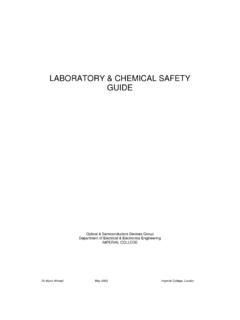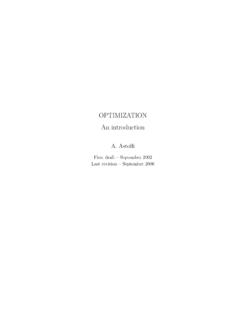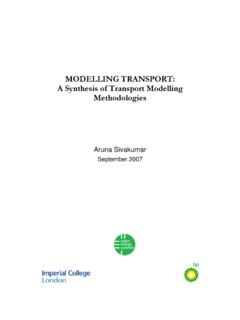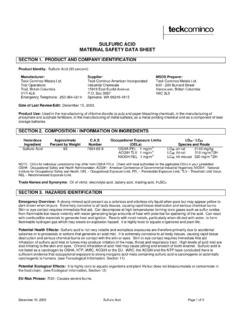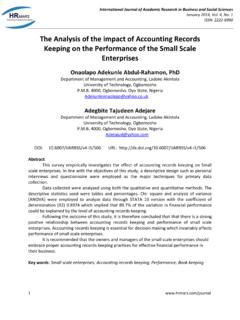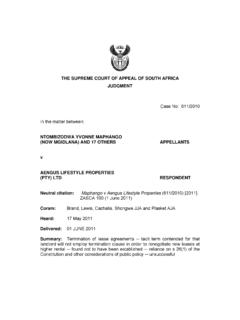Transcription of Finance Chart of Accounts Guide - Imperial College …
1 Finance Chart of Accounts Guide Index 3. Chart of 3. Changes to the Structure of the New Chart of 4. Balance Sheet 5. I&E Codes .. 5. Security 5. Mapping Spreadsheet and Migration of Balances.. 6. Financial Procedures & Information .. 7. Accounting Flexfield/GL 7. Other Coding Structures and Workflow .. 12. Procedures .. 12. Reports .. 17. Research Contracts Administration .. 18. Research Reports .. 19. Personnel and 20. Procedures .. 20. Personnel Reports .. 20. Appendix 1: College Building 21. Appendix 2: Common Activity Codes.
2 23. Appendix 4: Analysis Codes (I&E).. 28. Appendix 5: Analysis Codes (Balance Sheet) .. 43. Appendix 6: Category 56. Appendix 7 Detailed examples of changes in the use of 61. 2. Introduction The existing Chart of Accounts at Imperial College will change from February 2004 to the structure as indicated below. Changes to the Chart of Accounts have included the review and clean-up' of codes as well as changes to the physical structure of the Analysis segment. The change has had an effect on various ICIS modules at Imperial College and this document highlights the changes within each of the affected business areas.
3 All the changes for each department have been duly agreed to and signed off by the head of each department. Chart of Accounts The Chart of Accounts will be changed from 25 characters over 7 segments to 28. characters over 7 segments, as follows: Old Segment Length New Segment Length Company 2 Company 2. Cost Centre 5 Cost Centre 5. Activity 6 Activity 6. Analysis 3 Analysis 6. Indicator 1 Indicator 1. Sub 1 3 Sub 1 3. Sub 2 5 Sub 2 5. It is important to note that the old codes will not be disabled immediately but access to the codes will be restricted to specific users and for specific purposes only.
4 (Security rules will be put in place to control this). The old codes need to remain enabled, as the encumbrances that remain on the old codes will automatically create an entry to the old code when the invoice is matched. It is anticipated that the old codes will be closed following a clear down period of 2 to 3 months. Even then, codes may be opened and closed by a dedicated user as and when required. To assist in reporting and reconciliation, a new month-end process will transfer all old account balances to the new mapped Accounts for the next few months.
5 3. Changes to the Structure of the New Chart of Accounts Company Segment: No changes have been made to the company segment. Cost Centre Segment: There have been no structural changes to cost centre segment. However some departments used this opportunity to reduce the number of cost centres in use and replaced their structures with the new cost centre codes. Activity Segment: There are no structural changes to activity segment. However over 5000 activity codes have been either mapped to new activity codes and discontinued or mapped to analysis codes and discontinued.
6 Where the activity code was found not to be required, it has been discontinued. Several activities have been replaced with equivalent analysis codes to avoid duplication. In some cases, there has been one to one mapping of these codes, in others, entire account code combinations have had to be mapped. The default activity code G00000 has been used in those cases. However, there are also activity codes that have not changed. A new range of activity codes has been introduced to distinguish Staff Accounts ' from ordinary departmental activities.
7 These have been designated by Fxxxxx' range. It is important to remember that Gxxxxx' and Fxxxxx' activity codes should be viewed together when arriving at departmental surplus/deficit position. For budget purposes, budgeting will now have to be done down to the analysis code level for all activities. Analysis: The analysis segment denotes the type of income or expenditure incurred/. earned and is now 6 numeric characters in length. Several new analysis codes have been created which have been mapped from now defunct activity codes.
8 Also several new analysis codes have been created due to business need, examples of some detailed changes in analysis codes are explained in appendix 7. All analysis codes are MANDATORY and therefore the general codes /. Headcodes have not been replicated in the new Chart of Accounts structure ( there is no general code for Professional services'; the user will be required to use a specific analysis code for the particular type of professional service he/she is using). The only exception will be overtime staff pay codes, which can be used at the departments' option.
9 Workflow becomes introduced together with the new Chart of Accounts meaning that category codes used in purchasing will automatically generate an analysis code in GL as indicated in appendix 6. It is therefore crucial that category codes are used correctly as this will determine the accuracy of data reported in GL. Indicator: No changes have been made to the indicator segment. Sub1: No changes have been made to the Sub 1 segment. Sub 2: No changes have been made to the Sub 2 segment. 4. Balance Sheet Codes. The balance sheet codes will be represented mostly by a single analysis code with the cost centre and activity defaulted to 0' value.
10 Only departmental suspense Accounts will retain the departmental cost centre with 0' activity segment. Some central control Accounts , such as land and buildings and endowment funds will retain the existing Zxxxxx activity codes. The balance sheet codes consist of the Asset codes, the Liability codes and the owners Equity codes. All analysis codes in the range of 700000 799999 are Asset codes All analysis codes in the range of 800000 899999 are Liability codes All analysis codes in the range of 900000 999999 are Owners Equity codes.
